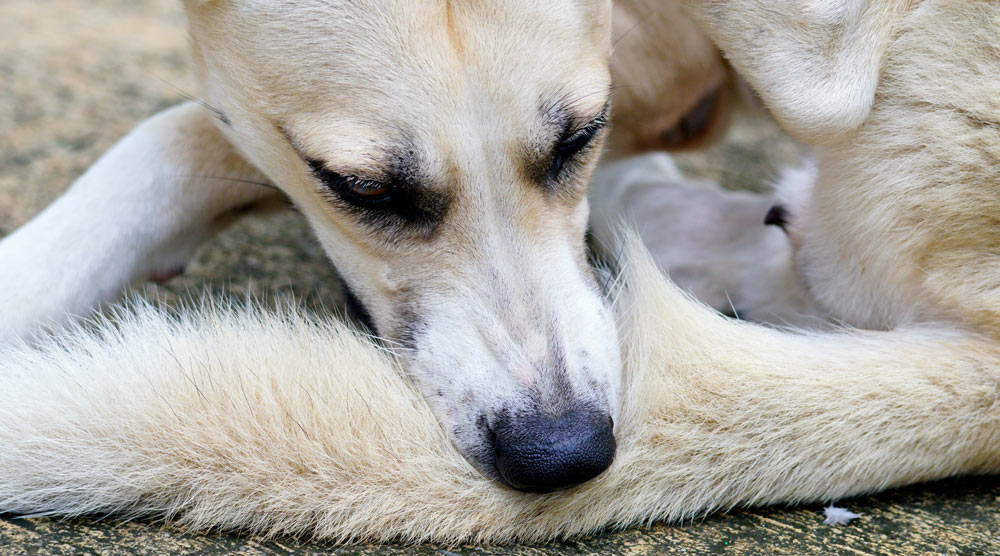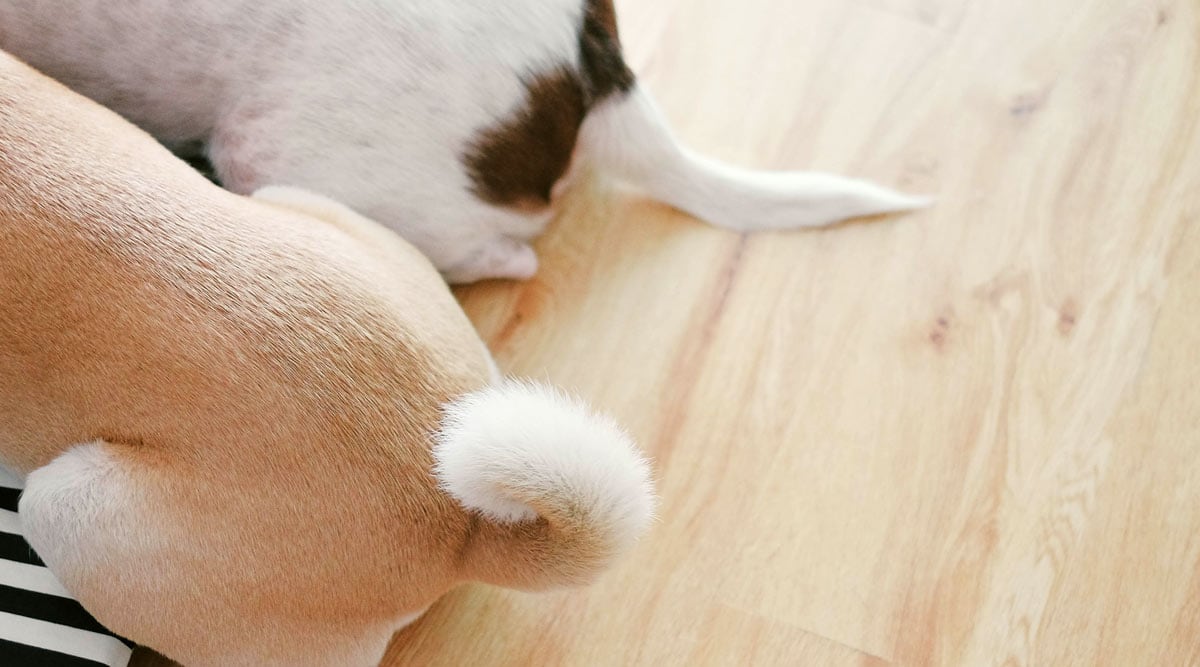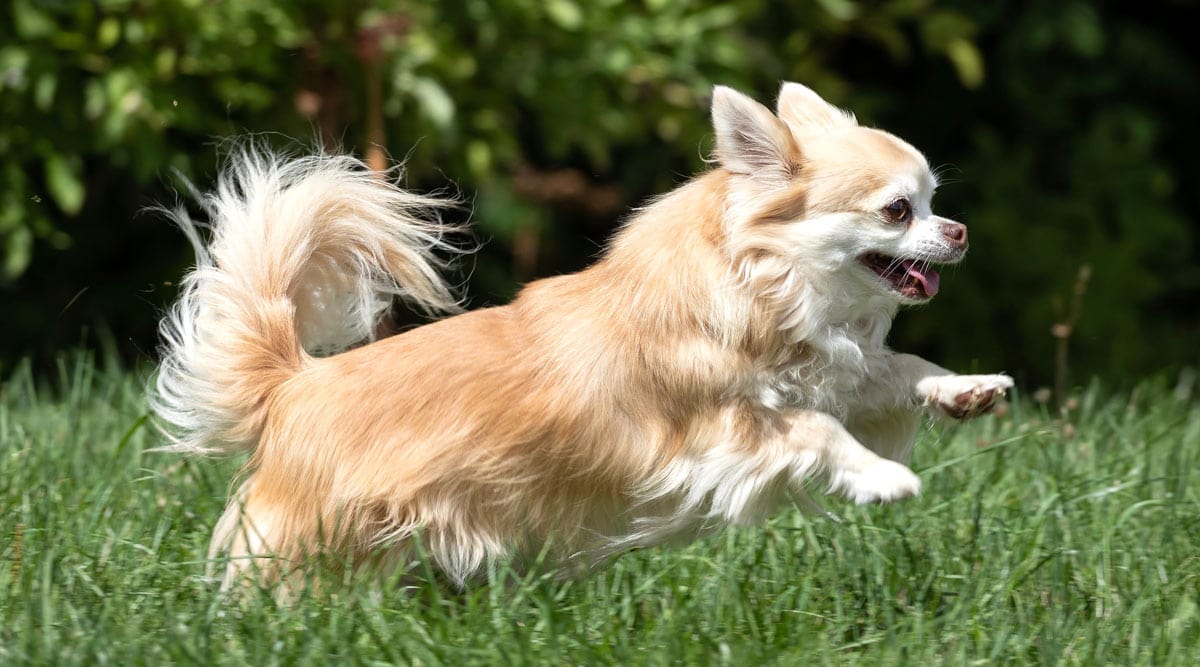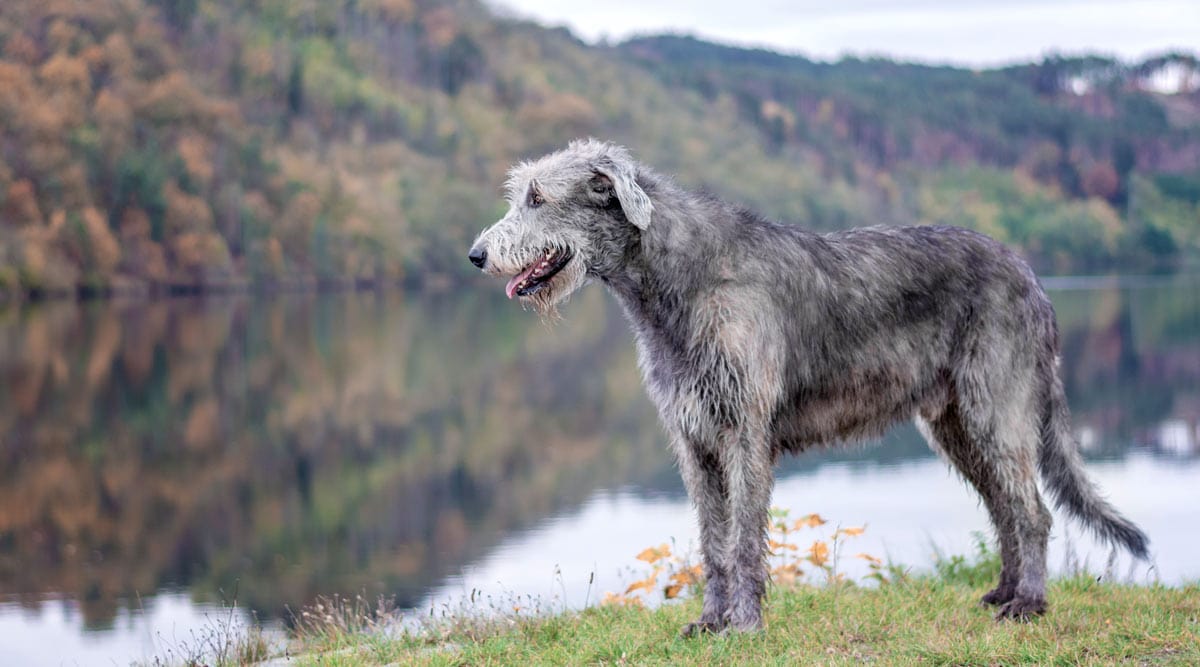Hair loss on the tail is a common issue for dogs. It’s often confined to specific bald patches or wounds, but can also occur evenly along the tail.
While it’s natural for dogs to shed hair (sometimes in large amounts!), you should never ignore bald spots or thinning hair on your dog’s tail. Abnormal hair loss can be a symptom of health conditions, ranging from hormonal imbalances to chronic stress.
In this article, we’ll discuss how to tell the difference between hair loss caused by biting and hair loss caused by a medical condition. We’ll also go through the most common causes of hair loss in the tail and how they might be treated.
Contents
Is Your Dog Biting or Chewing His Tail?
The first step in addressing your dog’s tail hair loss is determining whether your furry friend is excessively biting their tail.
Dogs might gnaw at their tails due to a variety of factors, ranging from allergies to stress. Essentially, anything that causes discomfort or a surge in stress hormones can trigger your dog to start chewing his tail. In some instances, self-biting might even be a symptom of obsessive-compulsive disorder in dogs.
“Dogs may chew their tails as a way of relieving tension or boredom, much like humans might bite their nails,” says dog trainer Rebecca Morello. “It’s a body part most dogs can reach in any position (aside from dogs with docked or naturally short tails) and so is easily accessible as a way to self-soothe.”
That said, not all tail hair loss is a result of biting or chewing. There are conditions, such as Cushing’s disease or mange, which cause hair loss and bald spots without the dog biting its tail.
Here are a few signs that your dog is chewing their tail excessively:
- The fur on the tail might be damp from saliva.
- The tail hair may look rough or broken.
- They may chase their tail a lot.
- If your dog is chewing his tail aggressively, there might be open sores or bald patches.
With these signs in mind, let’s look at some potential reasons why a dog might be chewing his tail to the point of causing hair loss.
Potential Reasons for a Dog Chewing Hair Off Tail
Flea Allergy and Infestation
Flea allergies are a common cause of excessive tail biting, which can lead to hair loss.
Of course, fleas are always a source of discomfort for dogs. But if your pup is also allergic to flea saliva, even a single bite on the tail can lead to intense irritation and aggressive tail biting. This itchiness can last for days in some cases, as per WebMD.
The most common symptom of a flea allergy is itching, but you may also notice hair loss and scabbing.
It’s always advisable to visit a vet for flea treatment. They can provide an effective treatment plan and give you tips for eliminating fleas in your home. Treatment usually involves flea medication, along with medication to alleviate itching.
Food or Environmental Allergies
Aside from flea allergies, food and environmental allergies can also lead to tail chewing. Both can cause itching and excessive biting, resulting in hair loss on the tail (or other areas of the body).
Unfortunately, identifying what’s triggering an allergic reaction can be a tricky task. Your vet will likely ask many questions to narrow down the possibilities, such as whether the itching is a year-round issue or if tail chewing gets worse after certain activities.
While allergies aren’t curable, they can be managed. Your vet may suggest medication, a dietary change, or adjustments to your dog’s environment, depending on the allergy trigger.
Intestinal Parasites
Intestinal parasites, like tapeworms, can cause itching and irritation around the anus. In some instances, this may lead your dog to bite the base of their tail, causing hair loss.
The treatment for this issue depends on the type of intestinal worm. It will almost certainly involve medication to eliminate the parasite.
Chronic Pain in the Tail
Pain can also cause a dog to chew or bite their tail. The chewing is the dog’s attempt to find relief, but over time, it can lead to hot spots and even open wounds.
Many issues can cause pain in the tail. Some examples include:
- Broken tail
- Tail wound
- Limber tail (caused by overuse of the tail muscles)
- Foreign object caught in the tail, such as a grass seed
- Arthritis in the tail
- Spinal issues or nerve damage
Always contact your vet if you suspect your dog is in pain.
Stress, Anxiety, or Fear
Similarly to pain, chronic stress or fear can cause a dog to chew their tail. This is often an attempt to distract from the negative emotions the dog is experiencing.
Look out for other signs of anxiety. These include whining or other vocalizations, lip licking, yawning, and the tail held down or between the legs.
You might also notice your dog compulsively chasing their tail. However, if your dog is most anxious when alone, you may not realize what’s happening until hair loss becomes visible.
It’s crucial to consult with a vet and a canine behaviorist about anxiety. Treatment may involve a combination of anti-anxiety medications, environmental changes, and behavioral modification training.
Anal Gland Problems
Anal glands are located beneath the base of the tail. If these glands develop issues, they can cause irritation and cause the dog to chew their tail. Over time, this can cause hair loss and bald spots.
Other symptoms of anal gland issues include:
- Scooting
- Suddenly looking at the back end or sitting down
- Pain when going to the bathroom
- Unpleasant smell
The treatment for an anal gland issue depends on the root cause. Sometimes the problem can be resolved by expressing the anal glands or administering antibiotics. However, in more severe cases, surgery might be required.
Potential Reasons for a Dog’s Tail Hair Falling Out
If you’ve ruled out excessive tail chewing causing hair loss, then one of the medical conditions below may be the issue. Hair loss is often related to hormonal imbalances, but can also be due to direct trauma or parasites.
Cushing’s Disease
Losing fur (including on the tail) and struggling with skin infections are common signs of Cushing’s disease. This condition is caused by the adrenal glands producing more cortisol (a stress hormone) than normal.
Some of the other signs of Cushing’s disease include:
- Increased thirst and urination
- Increased appetite
- Reduced activity levels
- An intolerance to heat
- Excessive panting
- Recurring skin infections
Hair loss in Cushing’s doesn’t usually start with the tail. It often begins around the belly, progressing along the back towards the tail.
Cushing’s disease should always be diagnosed and treated by a vet. They will be able to prescribe medication to manage your dog’s condition.
Hypothyroidism
Hypothyroidism, or an underactive thyroid, is another possible cause of tail hair loss.
This condition arises when the thyroid isn’t producing enough thyroid hormones. It can cause a wide range of different symptoms, including:
- Potbelly and weight gain
- Lethargy
- Intolerance to cold
- Dark skin pigmentation
- Dry or flaky skin
- Thinning hair
- Hair that doesn’t grow back after shaving
- High cholesterol
Unlike Cushing’s, hair loss in hypothyroidism often starts on the tail or the torso. Visit your vet if you notice any of the symptoms above, as they can run tests, confirm the diagnosis, and recommend effective treatments.
Tail Gland Hyperplasia (Stud Tail)
Tail gland hyperplasia, or “stud tail,” can leave a bald spot near the base of your dog’s tail. This issue is most common in intact males, hence the name, but can affect any dog.
Stud tail is caused by an overproduction of oily secretions, which can lead to hair matting and subsequent hair loss. If these secretions irritate your dog, they might also yank out the hair.
Other symptoms include skin discoloration, pain, and swelling. Always consult a vet if you spot these signs.
Demodectic Mange
Demodectic mange is another potential cause of tail hair loss. It occurs when mites living on the skin start multiplying too rapidly, causing patches of hair loss on the face and tail.
Early symptoms include crusty skin and irritation. Unlike many of the other conditions in this article, demodectic mange doesn’t usually cause itching to begin with, although this might develop as the condition progresses.
Demodectic mange is most common in young dogs, those with a compromised immune system, or senior dogs. It sometimes clears up on its own in young dogs, but you should still always visit a vet if you notice the symptoms.
Happy Tail Syndrome
Happy tail syndrome is a condition caused by a wagging tail repeatedly hitting hard surfaces, such as walls or a crate.
It can cause severe wounds, bleeding, and consequent hair loss. The skin inflammation from such injuries might also trigger tail biting or chewing, adding to the problem.
Despite its cheerful name, happy tail syndrome is a serious issue. It typically gets worse over time, so you should contact a vet immediately if you notice wounds on the tail.
For mild cases, tail bandages, protective gear, and antibiotics to prevent secondary infections may be sufficient treatment. However, for severe or chronic cases, partial amputation of the tail might become necessary.
When to Visit a Vet About Tail Hair Loss
Abnormal hair loss should always be checked by a veterinarian.
As detailed in this article, hair loss on a dog’s tail can be caused by a range of issues, so a professional diagnosis is important. Acting quickly also increases the chance of successful treatment.
Keep an eye out for other signs of illness in your dog that can help your vet diagnose the cause of hair loss. Examples include:
- Red, inflamed, or irritated skin
- Swelling along the tail
- Cracking of the skin
- Open wounds or bleeding
- Changes in appetite or thirst
- Unusual odours, such as a fishy smell
- Overly frequent biting or chewing of the tail
- Excessive chasing of the tail
- Any other behavioural changes
Does Tail Hair Grow Back?
Generally, tail hair does grow back once the underlying cause of hair loss or biting has been resolved. The best treatment depends on the cause of the problem, which is why a veterinary diagnosis is essential.
However, regrowth can take longer than you might expect. If you’re concerned about your dog’s tail hair not regrowing, or regrowing too slowly, then you should discuss this with your vet.




